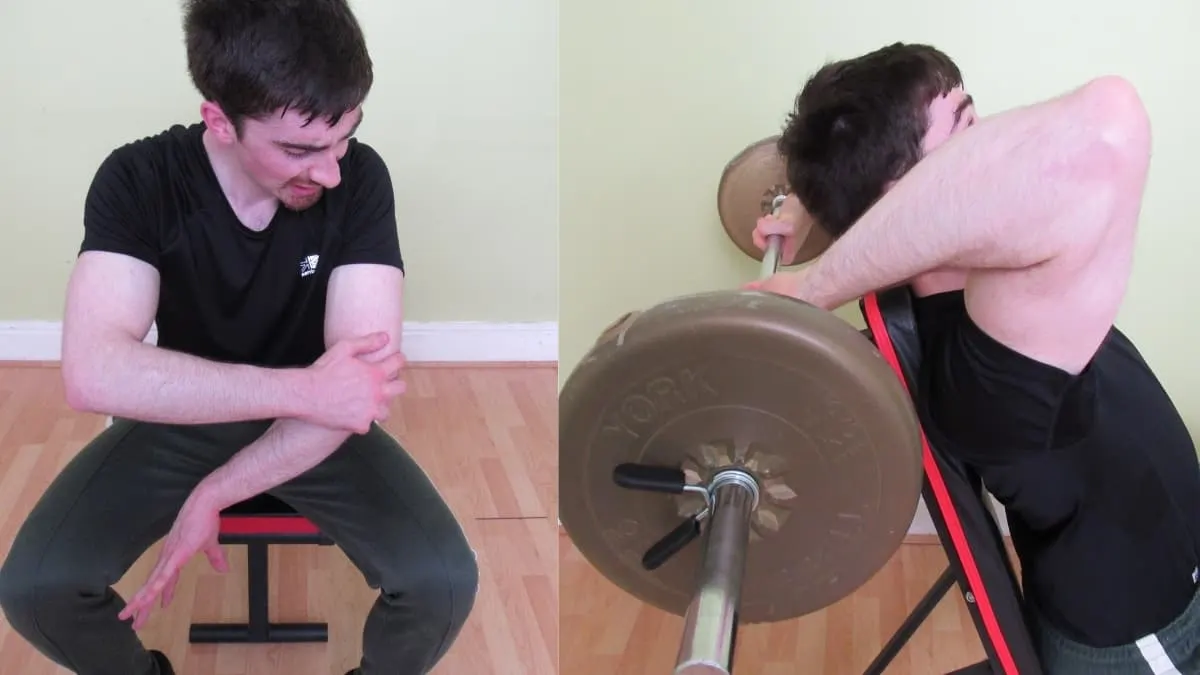If your elbow clicks, cracks, pops, or just plain hurts while working your triceps, then this guide is for you. You’ll learn the main reasons why you might be experiencing elbow pain after your tricep workout in general and after tricep extensions in particular.
After explaining why weight lifters often feel elbow pain during the tricep extension, we’ll explore some helpful solutions that have helped thousands of strength trainees recover from tricep training-related elbow pain.
Related: Safe tricep exercises
What causes elbow pain when doing weight lifting for the triceps?
If your elbow hurts when doing tricep extensions, pushdowns, or any substantially similar exercise, then there’s a good chance that the pain started as a mild clicking and cracking sensation and then gradually morphed into more painful symptoms.
This section covers some common causes of tricep extension elbow pain and explains how you can stop the discomfort, or, if you have a more severe injury, how you can minimize the chance of the pain reoccurring after you’ve recovered.
Also, bear in mind that your pain could be caused by a multitude of factors. This is another reason why it’s always a good idea to talk with your doctor, who might be able to refer you to a physical therapist for treatment.
Insufficient warm-ups
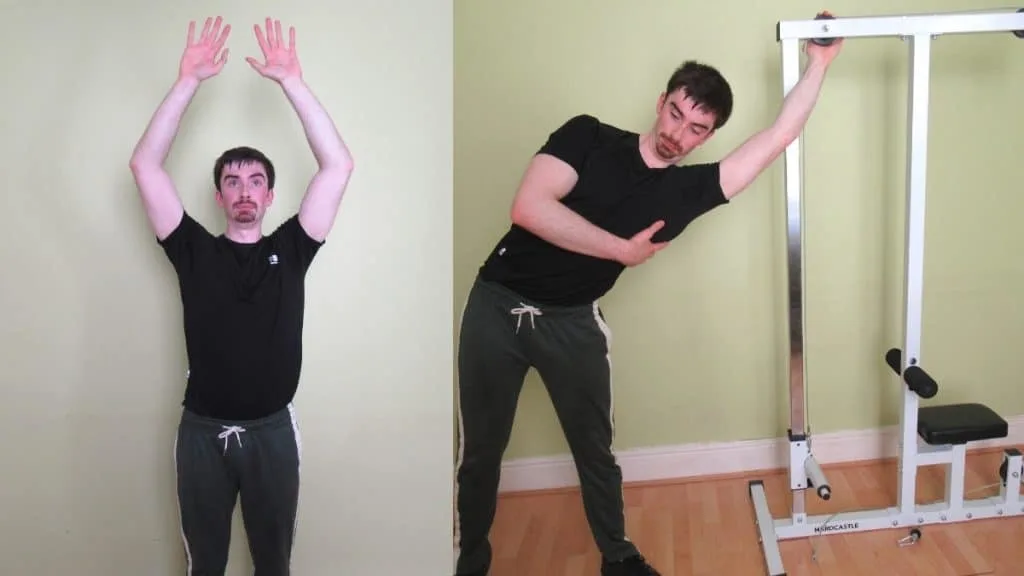
Barbell tricep extensions, pushdowns, and overhead extensions are all single-joint exercises where the elbows have to bear the brunt of the load.
But since these movements are also isolation exercises that work only one muscle, namely, the triceps brachii, lifters often don’t feel obliged to perform a thorough warm-up.
Yet, even if you’re lifting relatively light weights for your working sets, you still need to perform a proper warm-up so that your elbows are adequately lubricated.
As an example, 30 lbs might not seem like a lot of resistance. But when all of that force is going directly through a single elbow joint, the sheer amount of torque can often lead to pain if you haven’t performed a good warm-up routine.
Start with a light weight and perform 10-20 reps, but don’t train to failure. Then, increase the resistance by about 15-20% and do the same thing. Keep repeating the process until you reach your working weight.
Increasing the weight progressively enables you to quickly identify the resistance level at which you start to experience pain. If you can perform a given exercise pain-free with light to moderate weight but not with heavy weight, then that’s a good indication that you should stick to higher repetitions for that particular movement.
Incorrect exercise technique
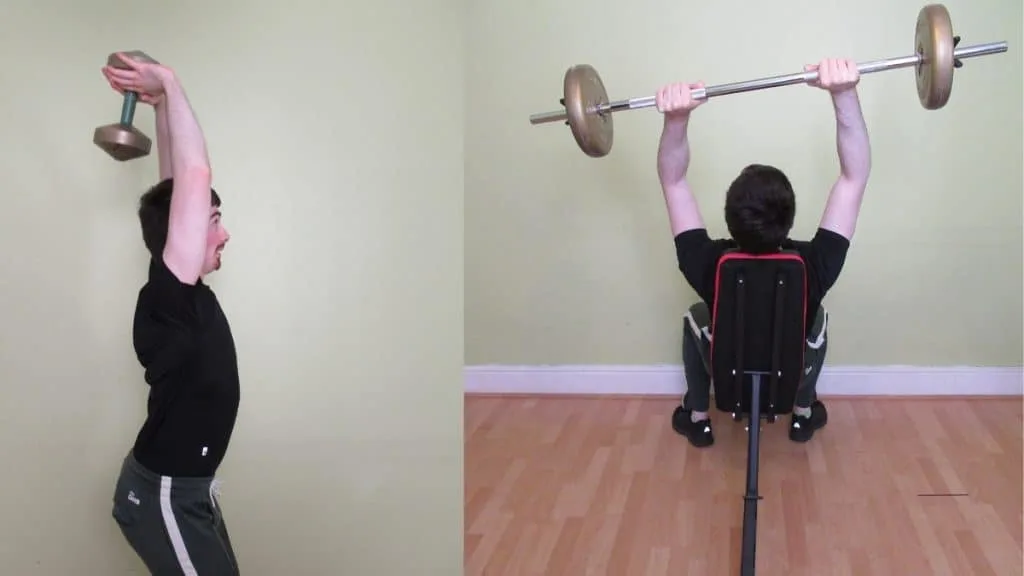
Many novice lifters and even some advanced strength trainees lift weights for their triceps with the incorrect technique. Besides providing your muscles with a suboptimal hypertrophic stimulus, using the improper form is also one of the most common elbow pain culprits when it comes to training the triceps.
Performing partial repetitions with excessively heavy weights is a well-known cause of joint pain in general and can definitely apply to the elbows when too much weight is lifted during extensions, pushdowns, and presses.
Yet, even when you perform full repetitions, you can still get elbow pain from tricep extensions. The more that you flex the elbow joint when the joint is under load, the more torque you’re putting through your elbow. The more torque that you put through a joint, the more likely it is to hurt and, if the offending exercise is performed regularly, become injured as well.
Excessive joint flexion could be a reason why skull crushers hurt your elbows. When you lower the bar to your face or, even worse, to your chin, you’re placing your elbows into a high degree of flexion by decreasing the angle at the elbow joint. [2]
Instead, when you’re doing lying down tricep extensions, you want to bring the bar behind your head by allowing your shoulders to move backward.
By engaging your shoulders to lower the bar behind your head, you’re now distributing the force over two joints rather than just one, which reduces the strain that your elbows get put under.
To make matters even better, bringing the weight behind your head rather than lowering it to your face places the long head of your triceps (the biggest head) under a greater stretch.
This is because the long head is the only triceps muscle that acts on the shoulder joint. And so, when you allow your shoulders to move backward during an extension, this important muscle head naturally does more of the lifting.
Connective tissue weakness
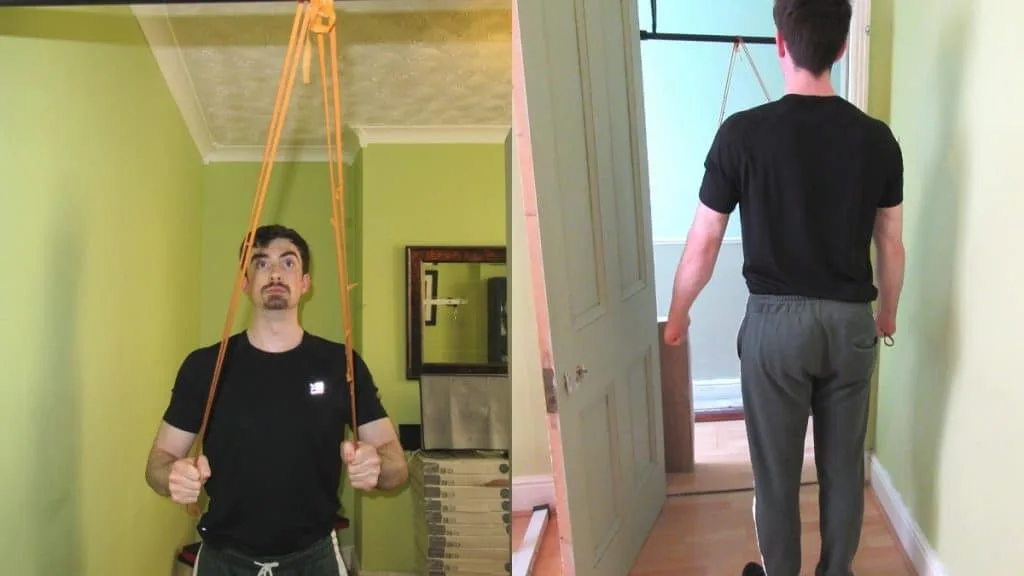
The triceps are an incredibly fast-twitch muscle that consists of a high proportion of type 2 muscle fibers. As such, the triceps grow exceptionally well from heavy, low rep lifting.
However, most people’s connective tissue strength simply cannot keep up with the power of their triceps. This is one reason why even advanced bodybuilders can run into elbow pain despite using good lifting technique; tendons and ligaments are much less durable and malleable than muscle tissue.
Strengthening your tricep tendons via high rep isolation exercises is an excellent idea because it gets your tendons used to handling plenty of tension without actually subjecting them to heavy resistance levels.
According to strength training expert Alexander Leonidas, high-rep pushdowns are a game-changing exercise for strengthening the connective tissue in your elbows. [4] But you needn’t go to the gym to do this kind of prehabilitation work.
All you need is a light resistance band that you can anchor to your door. From there, you simply perform around 100 reps of pushdowns (ideally 2-4 times per week) with a fast lifting tempo.
While this protocol won’t do much for your triceps, which respond much better to heavy weight and lower reps, it will strengthen your much weaker connective tissue structures (triceps tendon, ulnar-collateral ligament, lateral collateral ligament).
Elbow injuries
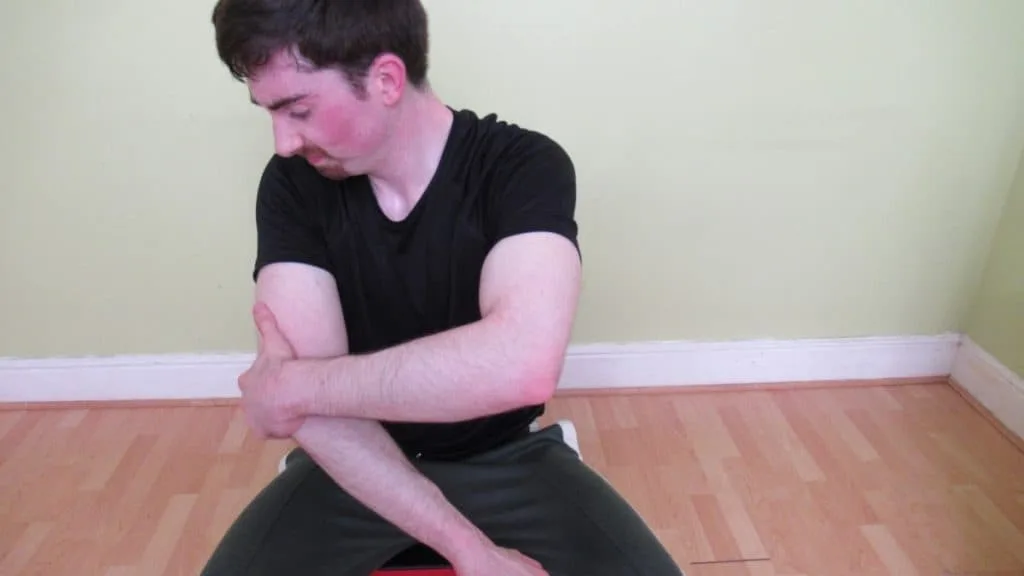
While you can make inferences about the cause of your elbow pain based on your symptoms, it’s virtually impossible to make an accurate diagnosis without talking to your doctor. Elbow pain is very different from simple tricep doms.
As mentioned, if your elbow hurts when you do tricep extensions, then there’s a good chance that your pain will become progressively worse if you don’t rest and recover. If this turns out to be the case (or if your pain has already got worse), then a common elbow injury that you might have is tennis elbow (lateral epicondylitis).
Tennis elbow pain is typically felt on the outside of the elbow, but the pain can also radiate down to your forearm and wrist. [5] Painful symptoms are brought on with the repetitive use of the gripping muscles, such as picking up a dumbbell at the gym or carrying grocery bags.
Strengthening your flexor and extensor muscles via weighted wrist extension and flexion exercises can help to make your forearms more resistant to stress, which in turn helps to minimize your risk of getting elbow injuries like tennis elbow.
Golfer’s elbow (medial epicondylitis) is similar to tennis elbow in that the pain is often caused and made worse by the repetitive use of the hand and fingers muscles. [6] With golfer’s elbow, however, the pain is felt on the inside of the elbow and can also spread to the inside of the forearm.
Elbow bursitis occurs when the olecranon bursa fills with more fluid than usual and becomes inflamed. [7] Direct trauma, such as falling on your elbow or hitting it on some equipment at the gym, is a common cause of elbow bursitis. However, putting pressure on the elbow for prolonged periods of time can also cause elbow bursitis to emerge over the course of many months.
Triceps tendonitis occurs when the triceps tendon becomes inflamed, which can happen when you perform a lot of repetitive, tricep-heavy movements like extensions and pitching (in baseball). [8]
Lifting too much weight
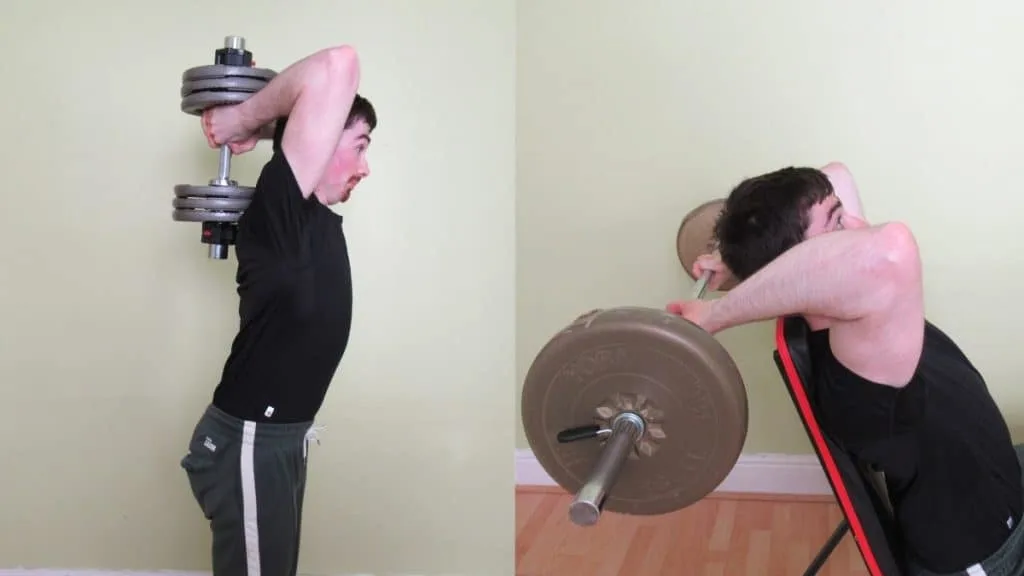
Many strength trainees are eager to improve their personal bests and impress other people in the gym by lifting weights that are too heavy for them.
If you can’t perform extensions or pushdowns with perfect form, then you should decrease the resistance so that you can improve your lifting technique.
The triceps are a relatively small muscle group, which means that they can’t handle all that much weight when you isolate them. While lifting heavy weights with good form is generally safe, you shouldn’t try to set new one-rep maxes on your tricep exercises (besides maybe close grip bench press).
Instead, stick to moderate or high repetitions on the majority of your elbow extension exercises.
The range of motion on tricep movements is relatively small anyway, so performing 10-20 reps per set will actually lead to better results than doing low reps (if the number of sets is equated) because you’ll be performing more total training volume, which is the primary driver of muscle hypertrophy.
Performing an excessive range of motion
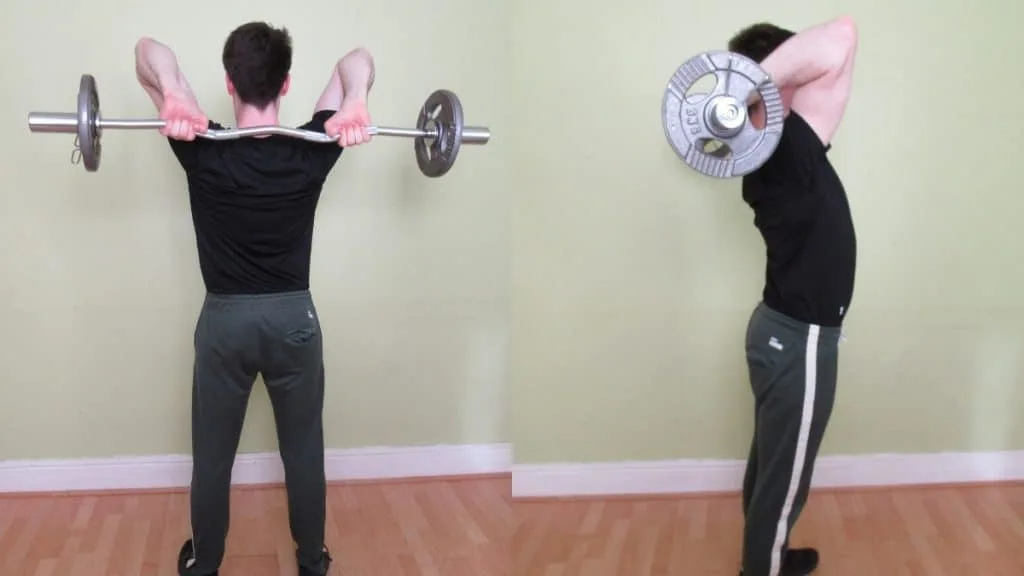
Achieving a good triceps stretch is crucial for muscle growth because the eccentric phase of the rep causes a lot of muscle damage and stimulates hypertrophy.
But you shouldn’t take the eccentric stretch to the extreme; more range of motion is only better up to a point.
According to sports physiology expert Dr. Mike Israetel, it’s normal to feel the weight pulling on your triceps tendon at the bottom of an extension rep. However, if you feel the pain directly in the elbow joint itself, then Israetel says that your range of motion is likely excessive but notes that an excessive ROM is a rarity considering that many lifters cheat their triceps out of growth by performing half rep extensions.
Performing an excessive ROM may actually make you weaker by 1) hurting your connective tissue structures and 2) by overstretching your triceps and reducing their ability to produce force.
The trick is to only lower the bar as far as you comfortably can while getting a proper triceps stretch in the process. But if you can’t get a full range of motion pain-free—even while using good form—then it may be that the specific exercise you’re doing isn’t a good fit for your bone structure. The inability to achieve a pain-free, full range of motion could also mean that you have an injury that needs treatment.
How can you prevent elbow pain during tricep extensions and pushdowns?
Lying and overhead tricep extension elbow pain can stop your weight training progress dead in its tracks by making it impossible to work out comfortably.
Yet, other exercises like the rope tricep extension and pushdown, which are considered to be more joint-friendly than their free-weight counterparts, can also cause your elbows to hurt during and after your workout.
Rest the affected area

Taking time off the gym is the last thing that any dedicated strength athlete wants to do.
However, if you want to maintain good long-term joint and connective tissue health, then taking time away from tricep training, upper body workouts, and even the gym altogether is often the best course of action for recovery.
If a particular exercise hurts your elbows, then immediately stop performing it. Joint pain is an indication of a problem, and you don’t want to exacerbate your symptoms by training through the pain.
If your symptoms aren’t particularly severe, then you may still be able to train your upper body. Bear in mind, however, that heavy pulling exercises and even bicep curls put a lot of tension through the elbow joints. So only train your upper body if you can do so pain-free.
Ice your elbow after the workout
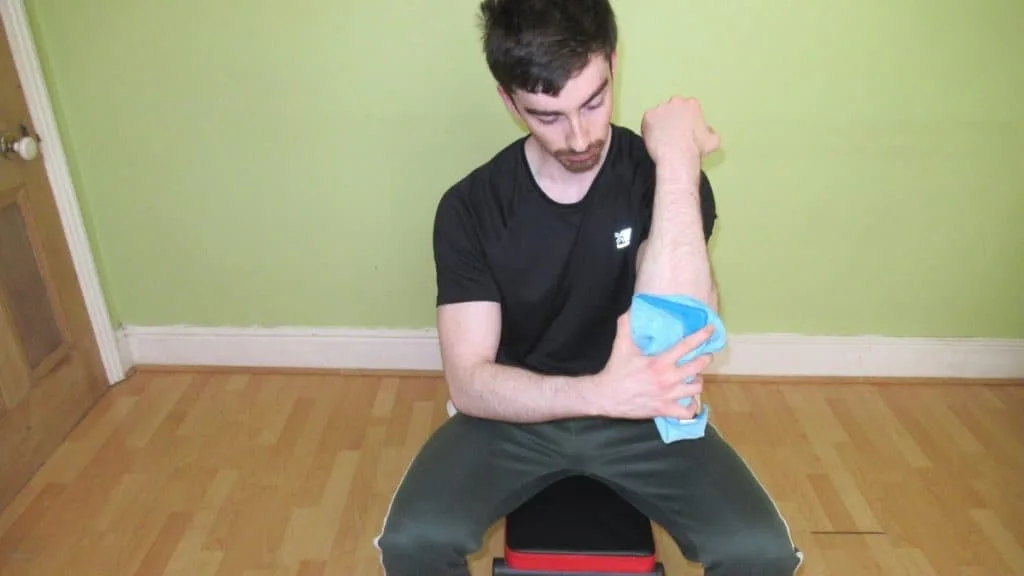
If you’re experiencing elbow pain after your tricep workout, then icing the affected area for 15-20 minutes every 4-6 hours can help to reduce inflammation and swelling, according to sports medicine expert Dr. Edward Laskowski. [10]
Just make sure to put a thin cloth between the ice pack and the affected area so that you don’t get ice burn on your skin. [11] This is usually as simple as wrapping the ice pack in a small towel.
Elevating your elbow above the level of your heart can also help to minimize inflammation and swelling. But make sure that you elevate your elbow on a comfortable surface such as a cushion; elbow bursitis can actually be brought on by pressing your elbow joint against hard surfaces for prolonged periods of time.
Wear an elbow sleeve
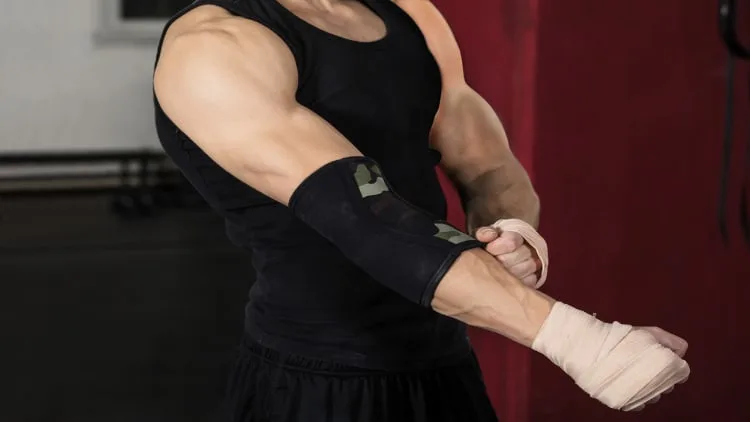
Wearing an elbow sleeve or compressing the affected area with a light medical bandage can also help to reduce inflammation by promoting better blood flow around your elbow joint. [12]
In this regard, wearing an elbow sleeve, while not in any way a replacement for a proper warm-up, can help your elbows to remain warm while you’re resting, which may help your joints to stay lubricated.
Wearing a splint brace, which restricts movement to a much larger degree than an elbow sleeve, is a useful tool for more severe injuries because it prevents you from putting excessive amounts of pressure on the joint.
Try other exercises
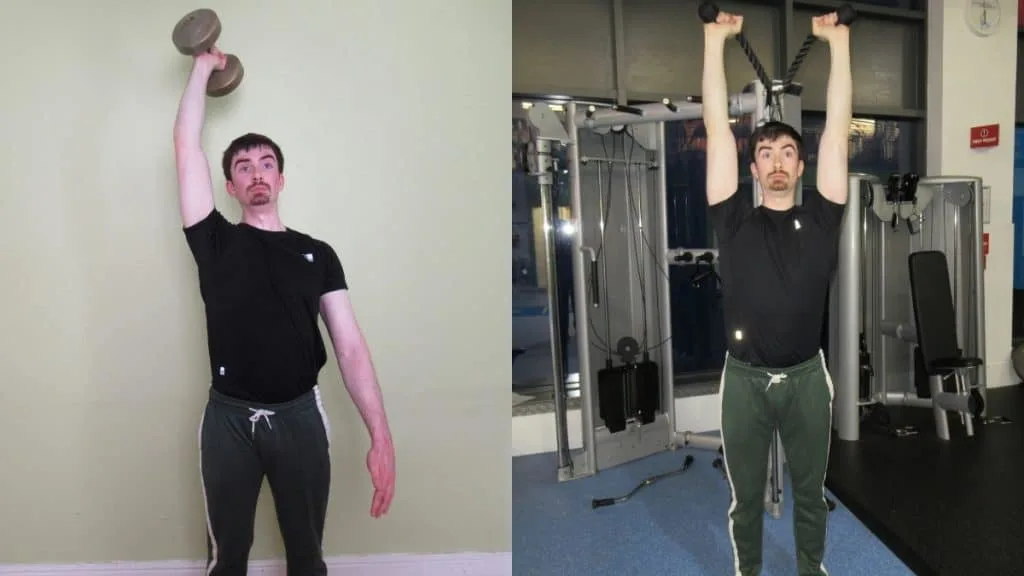
If you can’t do a certain exercise pain-free, then it’s possible that the peak torque of the offending movement occurs when your elbows are either near full extension or under a substantial stretch.
In both of these positions, a lot of force is going through the elbow joint.
Training unilaterally (as in a standing one arm dumbbell overhead triceps extension) may help to alleviate the discomfort because you’ll be lifting less total weight. Similarly, training one arm at a time affords you better focus, which means that you can pay closer attention to your form (exercising in front of a mirror can also help in this regard).
But if even cable-based exercises hurt your elbows, then you can seek out a good cable rope tricep extension substitute—ideally one that distributes the force over multiple joints so that your elbows don’t have to handle all of the resistance by themselves.
Performing a tricep extension with a band rather than with free weights can also help to stop your elbows from hurting. This is because bands provide more consistent tension than free weights, which means that your muscles (rather than your joints) receive a greater share of the tension during all parts of the rep.
Get a proper diagnosis
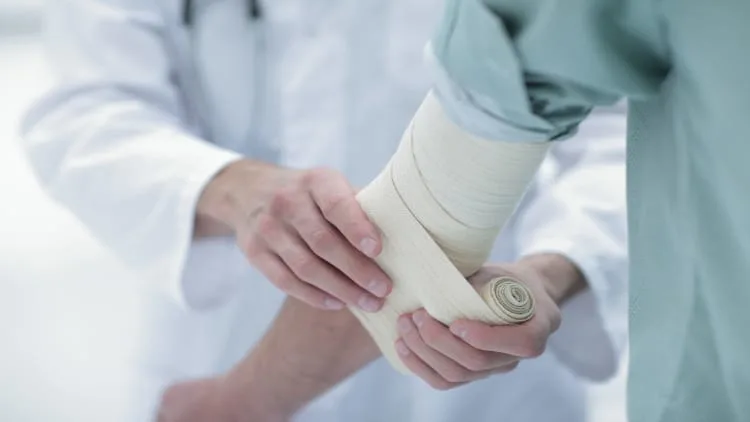
General advice can help you to identify your symptoms and the possible causes of your pain. But it’s no substitute for consulting with a qualified health professional.
Make sure to talk to your doctor about your tricep extension-related elbow pain. They might refer you to a physical therapist who can create a personalized treatment plan for your specific problem, which could help to speed up your recovery time.
Read More: Tricep extension shoulder pain
Conclusion: How to stop your elbow hurting during tricep extensions
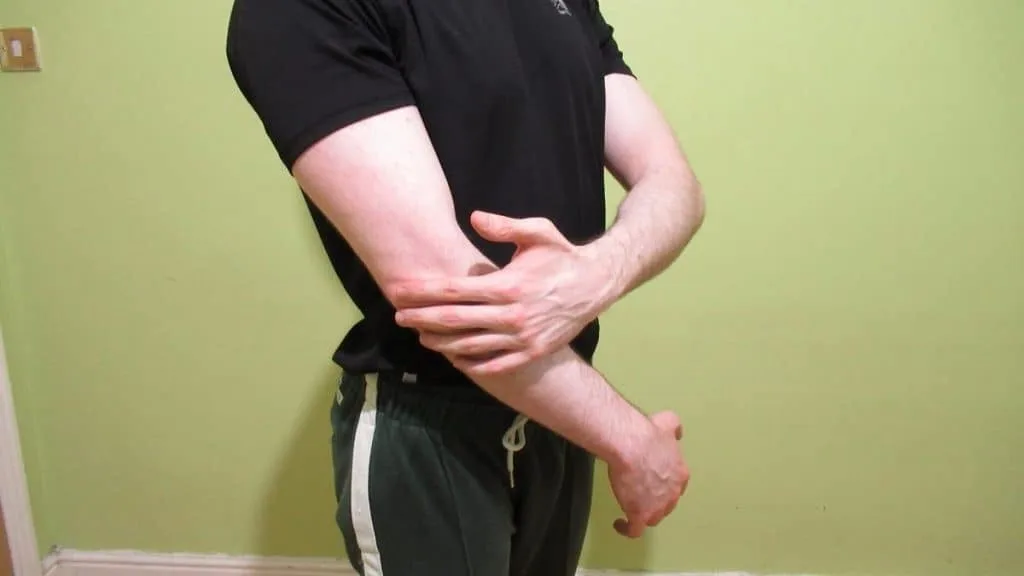
If tricep extensions of any kind—whether it be with a bar, dumbbells, or some kind of pushdown—hurt your elbows, then make sure to stop performing the exercise immediately.
If you can do other exercises pain-free, then perform those movements instead while keeping an eye on your form to make sure that you’re using a safe lifting technique. Lifting in front of a mirror can help in this regard because you can ensure that your elbows aren’t flaring out too much and that you’re not using an excessive range of motion.
Additionally, performing a thorough warm-up will help to lubricate your joints and promote blood flow to your connective tissue structures, which in turn can help to protect against injuries like triceps tendonitis.
Since extensions are a single joint exercise, your elbows have to bear the brunt of the load. For this reason, it makes sense to stick to higher repetitions (10-20) so that you don’t put too much torque through your joints.
References
- Triceps tendonitis: Signs, symptoms and treatment options. (2018, January 5). [Video]. YouTube. https://www.youtube.com/watch?v=9YE7-eeiEDw
- The Healthline Editorial Team. (2019, August 16). Elbow Flexion: What It Is and What to Do When It Hurts. Healthline. https://www.healthline.com/health/bone-health/elbow-flexion
- AlphaDestiny. (2016, December 2). How to Eliminate ALL Elbow Pain From Triceps Extensions! [Video]. YouTube. https://www.youtube.com/watch?v=S31_AyLUMcM
- Leonidas, A. (2019, April 6). The Elbow Pain Solution. OutAlpha. https://outalpha.com/the-elbow-pain-solution/
- Healthwise Staff. (2020, November 16). Tennis Elbow | Michigan Medicine. University of Michigan Health. https://www.uofmhealth.org/health-library/hw225372
- Golfer’s elbow – Symptoms and causes. (2020, October 10). Mayo Clinic. https://www.mayoclinic.org/diseases-conditions/golfers-elbow/symptoms-causes/syc-20372868
- Elbow Bursitis. (2019, September 11). Mayo Clinic Orthopedics & Sports Medicine. https://sportsmedicine.mayoclinic.org/condition/elbow-bursitis/
- Triceps tendonitis. (2021). Physiopedia. https://www.physio-pedia.com/Triceps_tendonitis
- 11 Overhead Tricep Extension Mistakes and How to Fix Them. (2020, September 10). [Video]. YouTube. https://www.youtube.com/watch?v=2A77zKWdAN4
- Tendinitis pain: Should I apply ice or heat? (2020, October 8). Mayo Clinic. https://www.mayoclinic.org/diseases-conditions/tendinitis/expert-answers/tendinitis/faq-20057872
- Brouhard, R. (2021, August 26). Avoid Placing Ice Packs Directly on Your Skin to Avoid Frostbite. Verywell Health. https://www.verywellhealth.com/frostbite-with-an-ice-pack-1298334
- HealthStatus. (2020, May 21). Essential Health Benefits Of Effective Elbow Compression Sleeves. HealthStatus. https://www.healthstatus.com/health_blog/back-shoulder-joint-pain/essential-health-benefits-of-effective-elbow-compression-sleeves/

